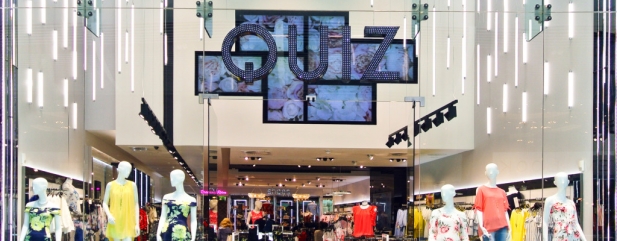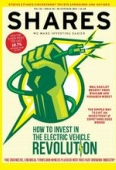Archived article
Please note that tax, investment, pension and ISA rules can change and the information and any views contained in this article may now be inaccurate.
Newly-listed retailer targets five-fold increase in sales

Given a UK consumer slowdown, the inexorable channel shift to the web and cut-throat competition amongst clothing retailers, investing in a ‘fast fashion’ womenswear outfit engaged in a physical store roll-out might not appeal to every investor.
So how has Quiz (QUIZ:AIM) managed to capture investors’ interest and successfully join the stock market (July 2017) despite the difficult backdrop for the retail sector? To answer this question, let’s take a closer look at the business.
Glasgow-headquartered Quiz is among a new breed of ultra-fast fashion brands disrupting the retail market place. Think ASOS (ASC:AIM) and Boohoo.com (BOO:AIM) rather than Marks & Spencer (MKS) or Bonmarche (BON).
Fast fashion is essentially retailers constantly producing new designs to feed a hungry market for womenswear. It involves a greater number of orders being placed at the last minute, typically taking inspiration from what celebrities have been wearing.
Quiz specialises in occasion wear and dressy casual wear that helps females, mainly in the 16-35 year old age bracket, stand out from the crowd.
Distinctive, glamorous own-brand lines are growing rapidly. And just like fast-fashion winners ASOS and Boohoo, Quiz boasts a burgeoning social media following and is successfully leveraging celebrity and blogger collaborations to raise brand awareness and boost sales.
Previous struggles
The business went into administration in 2009 after struggling with high rental costs and difficult trading conditions. The Ramzan family (which includes the founder and various directors) immediately bought back the majority of the business. Eight years later Quiz is in good health.
‘We see ourselves as an omni-channel version of the online pure plays that are out there,’ says chief commercial officer Sheraz Ramzan.
‘We tick all the boxes of social media, fast fashion and value. We have a very strong occasion wear offer – proms, weddings and nights out – and a strong casual dress offer. And the Quiz brand has got wide appeal. Go into our stores and you’ll see three generations of women shopping with us.’
Quiz constantly develops its own product lines, ensuring the latest glamorous looks are available at value prices. Today, Quiz trades in 300-plus outlets globally – including standalone stores, concessions with the likes of Debenhams (DEB) and House of Fraser, franchise stores, wholesale partners and international online partners including Zalando.
Online only accounted for 13% of last financial year’s sales but there is rapid growth in this channel.
Spending more money on marketing
July’s stock market listing raked in £9.4m of new money after fees which will help Quiz grow its market position at home and overseas. It plans to significantly increase marketing spend to help accelerate sales growth.
The growth potential is arguably huge as Quiz’s share of the £7.3bn UK womenswear value clothing sector alone is still tiny.
The £220m cap has significant online potential, rising brand awareness, helped by the UK store presence and increasing online activity, as well as the well-invested infrastructure to support planned growth.
Physical stores are important to Quiz’s omni-channel model; it currently trades from 67 standalone UK stores and there’s long term potential for a disciplined rollout to 110-120 locations.
Furthermore, it now has a flexible store estate centred on short leases, which limits exposure to costly upward rent reviews.
Sheraz Ramzan says: ‘The stores are an important part of the strategy but the main drivers are online and international.’ The latter channels are presently generating compound annual growth rates north of 40%.
Test and repeat model
Quiz has a durable competitive advantage over many of its peers thanks to the rapid speed by which it can produce items to meet the latest fashion trends.
Its test and repeat model is similar to BooHoo’s in that both companies do a small amount of orders to gauge customer demand and they only proceed with large orders for the most successful items.
This helps to limit the risk of having goods that are suddenly out of fashion and avoid having lots of unwanted stock that has to be sold at a discount, thus hurting profit margins.
Quiz achieves 62.7% gross margin and 9.1% EBIT (earnings before interest and tax) margin, according to stockbroker Panmure which has analysed a range of retailers’ latest reported financial results.
In comparison, online rival ASOS has 50% gross margin and 4.4% EBIT margin; and physical store rival New Look has 51.3% gross margin and 5.3% EBIT margin.
Future dividend payer
Quiz is cash generative with an ungeared balance sheet which not only supports growth ambitions but also provides protection should trading become tougher.
The company’s shares may interest income and growth investors alike as progressive dividends are on the horizon.
‘We’ve always been debt averse over the years,’ says Sheraz Ramzan. ‘We’ve always wanted to be a lean, fast-moving company that is flexible in every area.’
Targeting five-fold increase in sales
The company has outlined an initial ambition to build a £500m+ revenue brand in the medium term and a global omni-channel presence. To put that in context, Quiz generated £89.8m sales in the year to 31 March 2017.
Panmure Gordon analyst Peter Smedley forecasts sales to hit £116.4m in the year to March 2018 and £150.5m in the year after. That translates into pre-tax profit of £10.3m in 2018 and £12.6m in 2019.
The shares at 178p currently trade on 27.8 times forecast earnings for the current financial year. That’s a high rating to reflect its fast growth potential but nowhere near the 70.5 PE (price to earnings) ratio for BooHoo and 78.6 PE ratio for ASOS.
Important information:
These articles are provided by Shares magazine which is published by AJ Bell Media, a part of AJ Bell. Shares is not written by AJ Bell.
Shares is provided for your general information and use and is not a personal recommendation to invest. It is not intended to be relied upon by you in making or not making any investment decisions. The investments referred to in these articles will not be suitable for all investors. If in doubt please seek appropriate independent financial advice.
Investors acting on the information in these articles do so at their own risk and AJ Bell Media and its staff do not accept liability for losses suffered by investors as a result of their investment decisions.

 magazine
magazine










